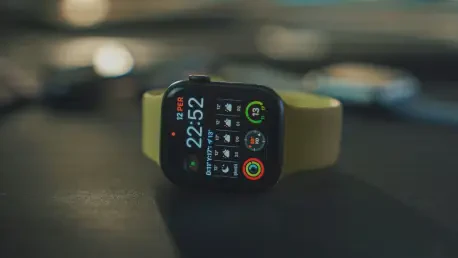Oscar Vail, a renowned expert in technology, is deeply engaged with emerging fields such as quantum computing and robotics. On the forefront of advancements within the industry, Oscar provides valuable insights into the consumer electronics landscape, including the smartwatch market where Apple finds itself facing challenges. In this interview, Oscar discusses the impact of declining sales, consumer sentiments, and the strategic moves needed for Apple to regain its stronghold.
How concerning is the two-year decline in Apple Watch sales for the company’s future in the smartwatch market?
Sales declines over consecutive years inevitably raise alarms for any business, especially a leader like Apple in the smartwatch domain. While Apple has built a vast ecosystem that will keep it relevant, this trend underscores a need for critical introspection. Apple must assess its strategy and invigorate its product line to maintain consumer interest and fend off competition that’s growing more aggressive each year.
What are the primary factors contributing to the sales decline of the Apple Watch over the past two years?
The primary contributors have been Apple’s lack of compelling new models along with modest updates in its recent offerings. This environment has fostered perceptions of stagnation among consumers. Add to this the surge in competition from brands like Huawei and Xiaomi, which are introducing feature-rich options at competitive pricing — all these factors have cast a shadow on Apple’s growth trajectory.
How has the absence of new models like the Apple Watch Ultra 3 and Watch SE impacted consumer interest and sales?
The absence of these models has likely left a noticeable gap in Apple’s product lineup, leading consumers to perceive a lull in innovation. When tech-savvy buyers don’t see the expected evolution in available choices, they start exploring alternatives. Apple’s consistency in releasing anticipated updates helps draw attention and maintain engagement, which wasn’t evident this time around.
What specific updates did the Apple Watch Series 10 include?
The Series 10 incorporated some basic upgrades, such as slightly improved battery life and fitness features. However, these changes were considered modest because they did not deliver game-changing innovations nor did they significantly differentiate from previous models, leaving consumers longing for more substantial advancements.
How have competitors like Huawei and Xiaomi affected Apple’s market share in the smartwatch segment?
Both Huawei and Xiaomi have aggressively expanded their product features while keeping affordability at the forefront. This strategic move has significantly undermined Apple’s market dominance, luring consumers who might prioritize diverse functionalities and upgrades alongside value for money.
What features have Huawei and Xiaomi introduced in their smartwatches that appeal to consumers?
Both competitors have introduced advanced health monitoring tools, customized fitness tracking options, and impressive battery life enhancements. They offer varied models targeting different demographics and consistently update these offerings to remain attractive to consumers. This focus on multifaceted user appeals gives them a distinct edge in this competitive landscape.
What specific consumer feedback indicates growing dissatisfaction with the Apple Watch?
Negative feedback often focuses on the lack of innovative features that resonate with users. Issues such as the removal of functionalities, including the blood oxygen sensor, due to patent disputes, have frustrated loyal customers who expect cutting-edge tech and seamless user experiences from Apple. Users hold on to older models for longer periods when they feel the upgrades aren’t justified.
How have patent disputes affected Apple Watch features?
Patent disputes have reportedly forced Apple to withdraw or suspend integrating certain advanced features, like the blood oxygen sensor. These legal complications hinder technological progression and drive dissatisfaction as consumers miss out on improvements they anticipate with each new release.
Why are some consumers holding onto older Apple Watch models instead of upgrading?
A primary reason is they find newer models insufficiently compelling or notice only minor enhancements compared to their current devices. Without major value-adds or innovation leaps, the reasons to spend on upgrades seem unjustified, leading users to stick with their tried-and-true versions for prolonged periods.
What expectations do consumers have for the upcoming Apple Watch models, such as Series 11, Ultra 3, and SE 3?
Consumers anticipate significant enhancements in technology, particularly in health monitoring capabilities, battery performance, and software improvements. They expect Apple to deliver unique innovations that stand out from current market offerings, truly upholding the revolutionary reputation Apple is synonymous with.
What innovative features should Apple incorporate in future models to reverse the declining sales trend?
To transition the declining trend, Apple may focus on pioneering health tech innovations, ensuring compatibility improvements with broader Apple services, and reintroducing premium legacy features that consumers miss. Tackling competitive pricing while ensuring preeminence in functionality can also help reclaim market share.
In your opinion, can Apple regain its lost market share in the smartwatch segment? If so, how?
Absolutely, but it calls for strategic revitalization. Apple needs to reaffirm its value proposition, focusing on innovation-led product development that integrates unique features consumers actively seek. Understanding shifting consumer habits, preempting technological trends, and optimizing price point strategies could restore its market dominance effectively.









